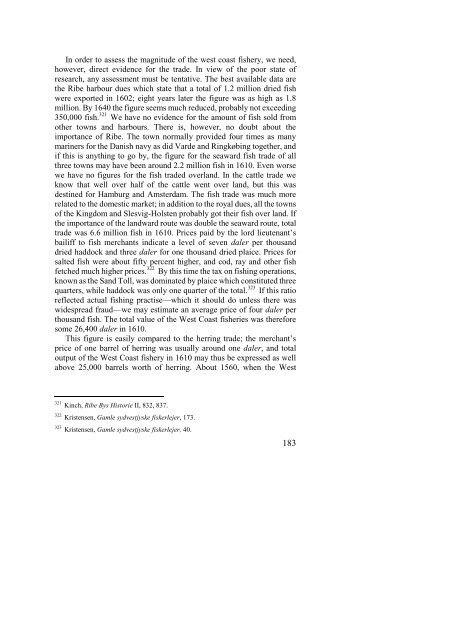The North Atlantic Fisheries, 1100-1976 - University of Hull
The North Atlantic Fisheries, 1100-1976 - University of Hull
The North Atlantic Fisheries, 1100-1976 - University of Hull
You also want an ePaper? Increase the reach of your titles
YUMPU automatically turns print PDFs into web optimized ePapers that Google loves.
In order to assess the magnitude <strong>of</strong> the west coast fishery, we need,<br />
however, direct evidence for the trade. In view <strong>of</strong> the poor state <strong>of</strong><br />
research, any assessment must be tentative. <strong>The</strong> best available data are<br />
the Ribe harbour dues which state that a total <strong>of</strong> 1.2 million dried fish<br />
were exported in 1602; eight years later the figure was as high as 1.8<br />
million. By 1640 the figure seems much reduced, probably not exceeding<br />
350,000 fish. 321 We have no evidence for the amount <strong>of</strong> fish sold from<br />
other towns and harbours. <strong>The</strong>re is, however, no doubt about the<br />
importance <strong>of</strong> Ribe. <strong>The</strong> town normally provided four times as many<br />
mariners for the Danish navy as did Varde and Ringkøbing together, and<br />
if this is anything to go by, the figure for the seaward fish trade <strong>of</strong> all<br />
three towns may have been around 2.2 million fish in 1610. Even worse<br />
we have no figures for the fish traded overland. In the cattle trade we<br />
know that well over half <strong>of</strong> the cattle went over land, but this was<br />
destined for Hamburg and Amsterdam. <strong>The</strong> fish trade was much more<br />
related to the domestic market; in addition to the royal dues, all the towns<br />
<strong>of</strong> the Kingdom and Slesvig-Holsten probably got their fish over land. If<br />
the importance <strong>of</strong> the landward route was double the seaward route, total<br />
trade was 6.6 million fish in 1610. Prices paid by the lord lieutenant’s<br />
bailiff to fish merchants indicate a level <strong>of</strong> seven daler per thousand<br />
dried haddock and three daler for one thousand dried plaice. Prices for<br />
salted fish were about fifty percent higher, and cod, ray and other fish<br />
fetched much higher prices. 322 By this time the tax on fishing operations,<br />
known as the Sand Toll, was dominated by plaice which constituted three<br />
quarters, while haddock was only one quarter <strong>of</strong> the total. 323 If this ratio<br />
reflected actual fishing practise—which it should do unless there was<br />
widespread fraud—we may estimate an average price <strong>of</strong> four daler per<br />
thousand fish. <strong>The</strong> total value <strong>of</strong> the West Coast fisheries was therefore<br />
some 26,400 daler in 1610.<br />
This figure is easily compared to the herring trade; the merchant’s<br />
price <strong>of</strong> one barrel <strong>of</strong> herring was usually around one daler, and total<br />
output <strong>of</strong> the West Coast fishery in 1610 may thus be expressed as well<br />
above 25,000 barrels worth <strong>of</strong> herring. About 1560, when the West<br />
321 Kinch, Ribe Bys Historie II, 832, 837.<br />
322 Kristensen, Gamle sydvestjyske fiskerlejer, 173.<br />
323 Kristensen, Gamle sydvestjyske fiskerlejer, 40.<br />
183















